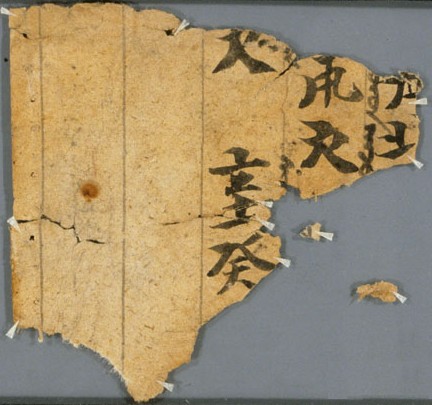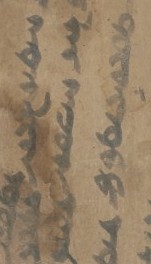BabelStone Blog
Thursday, 20 October 2011
Oh, How the Gods Mock Us!
On Boxing Day last year I wrote a blog post about the mystery of the two Khitan scripts in which I confidently asserted that "not a single manuscript or printed text in either Khitan script has survived". Ironically, less than a month earlier, on the 29th November 2010, my friend Viacheslav Zaytsev of the Institute of Oriental Manuscripts [IOM] in Saint Petersburg had announced his identification of a 100+ page manuscript codex as being written in the Khitan large script. This manuscript had been held at the IOM for many years, but as it was written in a cursive hand no-one had been able to identify the script with certainty. Most experts who had seen the manuscript had thought it was probably written in the Jurchen script, but by carefully comparing the text of the manuscript with memorial inscriptions written in Large Khitan, Viacheslav had been able to identify stretches of text that occured in both, and he was thereby able to prove for the first time that the manuscript was written in the Khitan large script. After finding out about Viacheslav's incredible discovery on 9 October, I made a correction to the offending blog post, confidently concluding that "this is the first and only manuscript written in either Large or Small Khitan to have been identified". And then a couple of days ago, Viacheslav kindly pointed me to an article written by Wang Ding in 2004 in which he discussed his identification in 2002 of a fragment of a paper manuscript held at the Berlin-Brandenburg Academy of Sciences and Humanities as being written in the Khitan large script. Although I haven't got anything much to add to Wang Ding's research, it is such an exciting yet exasperating discovery that I feel that it needs to be publicized.
This tiny fragment is not just a few random words scribbled on the back of a sutra, as is sometimes the case with Turfan and Dunhuang manuscript fragments, but from the neatly brushed calligraphy and neatly ruled guidelines it is clear that this is a fragment of a page from a carefully written text by a professional scribe that would probably have comprised at least several pages, maybe a whole book. Most significantly, to the right of each line of Khitan text are glosses in the Old Uyghur script, so if the whole text had survived it may well have acted as a Rosetta Stone, allowing for the decipherment of the as yet largely undeciphered Khitan large script. If only a single page of the text had survived then there would probably be enough to significantly improve our ability to read otherwise unreadable Khitan inscriptions. If only part of a page covering a few incomplete lines had survived then no doubt there would still be enough to enable us to learn the meaning or pronunciation of a few more Khitan characters. But this paltry fragment of tattered paper, the greater half of which is occupied by empty space, with just four complete and three partial Khitan characters clinging on to the runt side — what can it teach us of the lost Khitan language and its enigmatic script? Surely the Khitan gods are mocking us with this beautiful and tantalising fragment which hints at so much but tells us so little? We do not even know where this particular fragment was found; it is just an odd piece of paper that was picked up during one of the German expeditions to Turfan between 1902 and 1914, and ended up in the Berlin collection, miscatalogued as a Chinese divination text until Wang Ding recognised it in 2002. But, to be brutally honest, the scholarly value of this one fragment is extremely limited, and unless there are other surviving fragments of this text (extremely unlikely) we may never understand what exactly is written on it.
The table below is based on Wang Ding's research on the surviving text, with some notes and interpretations of my own.
Interpretation of the Khitan fragment Ch 3586
| Position | Khitan | Old Uyghur* | Notes |
|---|---|---|---|
| A.i | This character is too incomplete to identify with certainty, but it may be  or or  (two variants of the same character). This character occurs three times in the memorial for Yelü Ji 耶律褀 (1033–1108), each time immediately preceding the character (two variants of the same character). This character occurs three times in the memorial for Yelü Ji 耶律褀 (1033–1108), each time immediately preceding the character  . . |
||
| A.ii |  |
This is probably the left side of a character that is variously written  or or  or or  . This character has been interpretted as meaning "north" (Chinese běi 北) in some inscriptions, but it has also been interpretted as a phonetic transcription for Chinese characters pronounced shàng (e.g. 上 and 尚) in other inscriptions. It is quite similar to the character . This character has been interpretted as meaning "north" (Chinese běi 北) in some inscriptions, but it has also been interpretted as a phonetic transcription for Chinese characters pronounced shàng (e.g. 上 and 尚) in other inscriptions. It is quite similar to the character  , but the two characters are clearly distinguished in, for example, the memorial for Lord Dorlipun 多羅里本郎君 (1037–1080) where the sequence , but the two characters are clearly distinguished in, for example, the memorial for Lord Dorlipun 多羅里本郎君 (1037–1080) where the sequence   occurs at the very start of the inscription. occurs at the very start of the inscription. |
|
| B.i |  |
-urun ᠊ᠤᠷᠤᠨ |
This character is probably the same as  , which is an uncommon Khitan character of unknown meaning (there is also an uncommon Jurchen character of unknown meaning that looks like this). The Uyghur gloss -urun (or -orun) may represent either the end of a Uyghur word translating the meaning of the Khitan character or it may represent the pronunciation of the Khitan character. Wang Ding does not offer any suggestions for this gloss, but I wonder if this is not simply the common Uyghur word orun ᠣᠷᠤᠨ "place, seat, throne, territory, country". , which is an uncommon Khitan character of unknown meaning (there is also an uncommon Jurchen character of unknown meaning that looks like this). The Uyghur gloss -urun (or -orun) may represent either the end of a Uyghur word translating the meaning of the Khitan character or it may represent the pronunciation of the Khitan character. Wang Ding does not offer any suggestions for this gloss, but I wonder if this is not simply the common Uyghur word orun ᠣᠷᠤᠨ "place, seat, throne, territory, country". |
| B.ii |  |
qaču- ᠬᠠᠴᠤ |
The brush strokes of this character make it hard to clearly identify this character, but it is probably  , which is an uncommon Khitan character of unknown meaning. Wang Ding suggests that the Uyghur gloss qaču- (alternative reading qaǰu- as č and ǰ are not distinguished in OU) may be a phonetic transcription of the Khitan word meaning "iron", which is phonetically glossed as hé zhú 曷朮 in the History of the Liao Dynasty. On the other hand, I would suggest that qaču- could represent the start of the Uyghur word qačuɣ, meaning the "sphere of perception or sense " in a Buddhist sense, translating the Sanskrit āyatana or viṣaya (see Hamilton 1986 p.65). This would make sense as the majority of Turfan and Dunhuang manuscripts are Buddhist in nature, and both the Khitans and Uyghurs were mostly Buddhists, so there is a good chance that any Khitan-Uyghur manuscript would be a Buddhist text. , which is an uncommon Khitan character of unknown meaning. Wang Ding suggests that the Uyghur gloss qaču- (alternative reading qaǰu- as č and ǰ are not distinguished in OU) may be a phonetic transcription of the Khitan word meaning "iron", which is phonetically glossed as hé zhú 曷朮 in the History of the Liao Dynasty. On the other hand, I would suggest that qaču- could represent the start of the Uyghur word qačuɣ, meaning the "sphere of perception or sense " in a Buddhist sense, translating the Sanskrit āyatana or viṣaya (see Hamilton 1986 p.65). This would make sense as the majority of Turfan and Dunhuang manuscripts are Buddhist in nature, and both the Khitans and Uyghurs were mostly Buddhists, so there is a good chance that any Khitan-Uyghur manuscript would be a Buddhist text. |
| C.i |  |
-q ᠊ᠬ᠋ |
This looks as if it may be the same character as B.ii, although the top of the character is missing, so we can't be certain. The Uyghur gloss -q (Wang Ding gives an alternative possible reading of -in, but I think that can be discounted) has two prominent dots to the left, which are optionally used to distinguish the letter q from ɣ. If this character is indeed the same as B.ii then the trailing -q of this gloss fits perfectly with the leading qaču- of B.ii to form qačuq ᠬᠠᠴᠤᠬ᠋ which could plausibly be an alternate spelling for the Uyghur word qačuɣ ᠬᠠᠴᠤᠭ "sphere of perception or sense". |
| C.ii | |||
| C.iii |  |
ši- ᠱᠢ |
This character is unknown, but is probably a variant of  (yet another uncommon Khitan character of unknown meaning). Cf. the variant pair of Khitan characters, (yet another uncommon Khitan character of unknown meaning). Cf. the variant pair of Khitan characters,  and and  (both meaning "forty"), which show the same alternation of 土 and 丄 at the bottom. Its resemblence to the Chinese character xīn 辛 (the 8th celestial stem) may just be a coincidence, but on the other hand it is possible that the Khitan character is derived from the Chinese character 辛, and borrows its pronunciation, in which case the Uyghur gloss may be all that remains of šin. (both meaning "forty"), which show the same alternation of 土 and 丄 at the bottom. Its resemblence to the Chinese character xīn 辛 (the 8th celestial stem) may just be a coincidence, but on the other hand it is possible that the Khitan character is derived from the Chinese character 辛, and borrows its pronunciation, in which case the Uyghur gloss may be all that remains of šin. |
| C.iv |  |
This character is unknown, although several very common Khitan characters are written with a "fire" top like this (e.g.  and and  ), so it looks quite Khitan in form. Interestingly, it resembles the Chinese character guǐ 癸 (the 10th celestial stem), which seems almost too much of a coincidence given the preceding character resembles the 8th celestial stem. ), so it looks quite Khitan in form. Interestingly, it resembles the Chinese character guǐ 癸 (the 10th celestial stem), which seems almost too much of a coincidence given the preceding character resembles the 8th celestial stem. |
* The Uyghur transcriptions in italic type are based on the readings by P. Zieme in Wang Ding 2004. Note that the Old Uyghur text is hacked using Unicode Mongolian, so the glyph forms for some letters may not be exactly correct.
Part of Pelliot chinois 3072 showing the Uyghur word qačuɣ (middle word of the middle line)
Bibliography
- Wang Ding, "Ch 3586: ein khitanisches Fragment mit uigurischen Glossen in der Berliner Turfansammlung"; in Turfan Revisited: The First Century of Research into the Arts and Cultures of the Silk Road (Desmond Durkin-Meisterernst, Simone-Christiane Raschmann, Jens Wilkens, Marianne Yaldiz, Peter Zieme eds.). Berlin: Dietrich Reimer Verlag, 2004.
- James Hamilton, Manuscrits ouïgours du IXᵉ-Xᵉ siècle de Touen-houang Volume 1. Paris: Peeters, 1986.
Index of BabelStone Blog Posts

